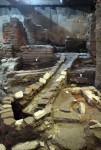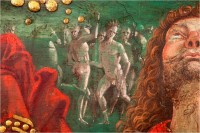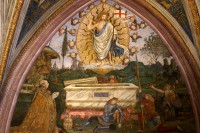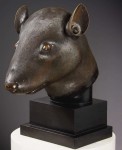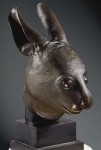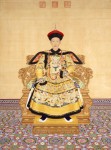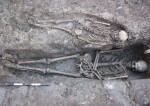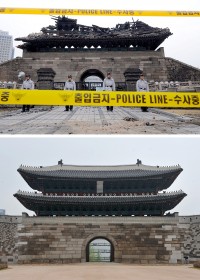 The Namdaemun, or Great South Gate, a wooden pagoda-style gate built in 1398 to serve as the main southern entrance to the walled city of Seoul, will officially reopen on Saturday, May 4th, after five years of painstaking restoration following a devastating fire.
The Namdaemun, or Great South Gate, a wooden pagoda-style gate built in 1398 to serve as the main southern entrance to the walled city of Seoul, will officially reopen on Saturday, May 4th, after five years of painstaking restoration following a devastating fire.
On 8:40 PM on Sunday, February 10th, 2008, a man climbed a ladder to the second floor of the gate, poured paint thinner on the floor and set it on fire with a disposable lighter. He quickly climbed back down and fled, leaving behind unused bottles of paint thinner, a backpack, disposable lighters and the ladder. Firefighters were on the scene promptly, but there was some confusion about whether the fire was still burning and the Cultural Heritage Administration had warned the crews to proceed with caution so as not to damage the ancient structure. When the conflagration blew up again, it was too large to put out immediately. By the end of the five hour battle to put out the blaze, the gate had collapsed and was a smoldering pile of wreckage.
 A suspect was apprehended the next day. A search of his home found a can of paint thinner and leather gloves used in the arson and he confessed immediately, pleading the public’s forgiveness. Apparently he destroyed this ancient and beautiful monument because he was mad at the government for ignoring a petition he filed complaining that property developers had not paid him proper compensation for land that had been expropriated to build an apartment complex. A four page screed on the topic was also found at his home by police.
A suspect was apprehended the next day. A search of his home found a can of paint thinner and leather gloves used in the arson and he confessed immediately, pleading the public’s forgiveness. Apparently he destroyed this ancient and beautiful monument because he was mad at the government for ignoring a petition he filed complaining that property developers had not paid him proper compensation for land that had been expropriated to build an apartment complex. A four page screed on the topic was also found at his home by police.
He was 69 when he committed this crime, hardly an impetuous youth, and it wasn’t the first he set fire to a historical monument. He was convicted in April of 2006 for setting a fire that burned down part of UNESCO World Heritage site Changgyeong Palace in Seoul. In an example of justice gone very wrong indeed, he was given a suspended 18-month jail sentence and a fine of a few thousand dollars. He was convicted of the arson of Namdaemun in October of 2008. The law learned too late from its mistake, but at least this time he got 10 years in jail, none of them suspended. Let’s hope he’s too old to climb ladders when he gets out.
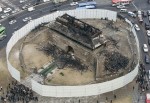 The destruction of the Namdaemun, officially named Sungnyemun, or The Gate of Exalted Ceremonies, was a devastating blow to the country. Seoul has lost a great many of its historic monuments to modernization, occupation and war. This ancient gate, one of four built along the walls protecting Seoul just six years after the city became the capital of the then-new Joseon Dynasty (1392 -1910), was the oldest wooden structure in the city. It was given the formal designation of National Treasure Number One in 1962 during a previous restoration to repair damage from the Korean War (1950-1953) and the Japanese Occupation (1910-1945). It was only opened to the public for the first time since the occupation in 2006.
The destruction of the Namdaemun, officially named Sungnyemun, or The Gate of Exalted Ceremonies, was a devastating blow to the country. Seoul has lost a great many of its historic monuments to modernization, occupation and war. This ancient gate, one of four built along the walls protecting Seoul just six years after the city became the capital of the then-new Joseon Dynasty (1392 -1910), was the oldest wooden structure in the city. It was given the formal designation of National Treasure Number One in 1962 during a previous restoration to repair damage from the Korean War (1950-1953) and the Japanese Occupation (1910-1945). It was only opened to the public for the first time since the occupation in 2006.
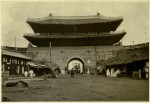 As horrific as the devastation was, there was still a fair amount of recoverable material from the site, enough to support a restoration. Authorities thankfully had made detailed architectural plans 182 pages long of the gate before opening it to the public in 2006, so restorers had accurate measurements and construction details to go on. However, given the opportunity to start from scratch, the government decided to restore the gate to its original form, rebuilding walls destroyed by the Japanese during the occupation and using only traditional construction methods. Instead of the modern paint and tiles employed during the restoration of the 1960s, this restoration would use only hand-made roof tiles fired in traditional kilns and natural paints, which had to be imported from Japan because there are no traditional paint manufacturers left in Korea, for the dancheong, the gloriously colorful decorative painting. Carpenters and stonemasons would use no power tools. It was hammers and chisels all the way.
As horrific as the devastation was, there was still a fair amount of recoverable material from the site, enough to support a restoration. Authorities thankfully had made detailed architectural plans 182 pages long of the gate before opening it to the public in 2006, so restorers had accurate measurements and construction details to go on. However, given the opportunity to start from scratch, the government decided to restore the gate to its original form, rebuilding walls destroyed by the Japanese during the occupation and using only traditional construction methods. Instead of the modern paint and tiles employed during the restoration of the 1960s, this restoration would use only hand-made roof tiles fired in traditional kilns and natural paints, which had to be imported from Japan because there are no traditional paint manufacturers left in Korea, for the dancheong, the gloriously colorful decorative painting. Carpenters and stonemasons would use no power tools. It was hammers and chisels all the way.
Before the first hammer could strike, historians spent two years researching how the gate had looked originally. Surviving workers from the 1961 restoration were consulted for their memories of what had been changed. Craftsmen worked painstakingly to salvage every last part of the burned structure. Bent nails were heated and straightened one at a time at a rate of 50 to 70 a day. One team identified and tagged each piece of burned wood using radio frequency identification to find whatever could be reused and to collect more information about how they had once been put together. They recovered an incredible total of more than 60,000 original wooden pieces to reuse during the restoration. The 68 stone animals on the roof were pieced back together from fragments.
 What could not be reused was recreated using materials as close to the original as possible. Pine wood from old growth trees, very rare in Korea today, was located so there would be time to fell the trees and cure them properly before using them. People flocked to donate pines from their property, so many that experts had their pick of the most noble pines left in the country. They ultimately chose 167 trees from 12 locations, including 20 trees from the Jungyeong Tomb in the city of Samcheok, the source of the pines used by the royal family during the Joseon Period. The total weight tally for the project was 26 tons of pinewood.
What could not be reused was recreated using materials as close to the original as possible. Pine wood from old growth trees, very rare in Korea today, was located so there would be time to fell the trees and cure them properly before using them. People flocked to donate pines from their property, so many that experts had their pick of the most noble pines left in the country. They ultimately chose 167 trees from 12 locations, including 20 trees from the Jungyeong Tomb in the city of Samcheok, the source of the pines used by the royal family during the Joseon Period. The total weight tally for the project was 26 tons of pinewood.
The roof tiles were almost obliterated by the fire, but 95% of them were factory-made versions installed during the 1961 restoration. All 23,369 of the new clay roof tiles were produced using traditional methods which result in a lighter weight, unique tile. This was no mean feat. According to traditional tile maker Han Hyung-joon of Jaewajang, who bears the outstanding title of Intangible Cultural Asset No. 91, there are only three kilns left in South Korea that produce traditional tiles. Making thousands and then shipping them to Seoul was tricky because the tiles can easily be cracked by temperature changes and damaged during transportation.
Master carpenter Shin Eung-soo (71) led the project, overseeing a team of 1,000 top woodworkers, stonemasons, blacksmiths and other craftsmen who had to work as their ancestors had. Even the tools themselves required research to find.
Lee Eui-sang, a 72-year-old mason who participated in the project, said the government’s plan to restore Sungnyemun in a traditional way perplexed him at first.
“I didn’t know what to do because all the tools used by the nation’s traditional masons disappeared in the middle of 1970s,” he said. So, he had to travel around the country in search of old tools.
“The past three years that I participated in the Sungnyemun restoration project were the most unforgettable experiences in my 55 years as a mason,” he said.
 The project was initially estimated to take three years to complete at a cost of $21 million. It took five years and $24.4 million, which really is impressively close to the estimate considering the kind of detailed handcrafting that went into recreating the gate in all its glory.
The project was initially estimated to take three years to complete at a cost of $21 million. It took five years and $24.4 million, which really is impressively close to the estimate considering the kind of detailed handcrafting that went into recreating the gate in all its glory.
On Saturday the gate will be reopened with a traditional cheondo ceremony to eliminate all bad luck and with a performance of traditional folk Korean folk song Arirang. The signboard on the front of the gate, repaired from surviving pieces of the old tablet with some new patching and now covered by a tarp, will be unveiled. Given the revival of traditional customs that this restoration has engendered, it’s eminently fitting that the reopening should feature the same ceremonies traditionally used to inaugurate new homes.



